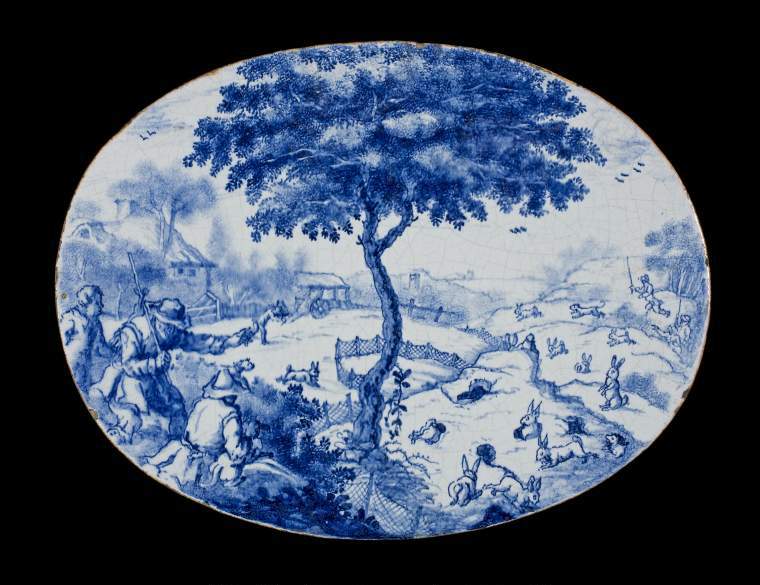Current Location: Gallery 31 (Armoury)
Titles
Coney Catching
Maker(s)
Pottery:
Unidentified Lambeth Pottery
(Probably)
Printmaker:
Hollar, Wenceslaus
(After)
Production:
Barlow, Francis
(After)
Entities
Categories
Description
Tin-glazed earthenware painted in blue
Oval plaque of buff earthenware covered with very shiny bluish-white tin-glaze, and painted in blue. The reverse is mainly unglazed but has a few small glazed areas. The front is decorated overall with a rabbit-hunting scene. In the middle a tree stands within a netting fence which runs in a wavy line into the distance. On the right of it there are nine rabbits and six rabbit holes. In the distance a man and a dog are driving a rabbit towards the fence. Three men are approaching from the left of the tree and behind them is a cottage or farm and another man moving towards the fence.
Notes
History note: Unknown owner near Braintree; Mr John E. Holmes, Eastbourne from whom purchased for £2 in Septmeber 1902 by Dr Glaisher, Cambridge.
Legal notes
Dr J.W.L. Glaisher Bequest
Measurements and weight
Height: 27.7 cm
Length: 36.5 cm
Acquisition and important dates
Method of acquisition: Bequeathed
(1928-12-07)
by
Glaisher, J. W. L., Dr
Dating
18th Century, Mid
George II
Circa
1735
CE
-
1745
CE
Note
Label text from the exhibition ‘Feast and Fast: The Art of Food in Europe, 1500–1800’, on display at The Fitzwilliam Museum from 26 November 2019 until 31 August 2020: Oval plaque depicting coney catching rabbits. Rabbits were a popular food across Europe, and their skins provided useful additional income. Some wealthy English landowners ensured year-round supplies through estate warrens (‘coningerys’). Building a warren required a licence, money, and land on which great earth embankments were constructed, and sown with gorse or fenced off, to keep the rabbits in and poachers out. As this plaque shows, warreners (‘coningers’) would use ferrets or dogs to drive rabbits from these man-made burrows into nets stretched over the entrances. Unidentified Lambeth pottery, England, c.1735– 45 Scene copied from an etching by Wenceslaus Hollar (1607–77) after Francis Barlow’s ‘Coney Catching’ from Severall Wayes of Hunting, Hawking, and Fishing, According to the English Manner (London, 1671)
The scene was copied from an etching by Wenceslaus Hollar after Francis Barlow' s 'Coney Catching' from 'Several Wayes of Hunting Hawking and Fishing, according to the English Manner', London, 1671.
People, subjects and objects depicted
Components of the work
Decoration
composed of
cobalt
Materials used in production
Tin-glaze
Earthenware
Techniques used in production
Tin-glazing
: Tin-glazed earthenware painted in blue
References and bibliographic entries
Related exhibitions
Identification numbers
Accession number: C.1571-1928
Primary reference Number: 72242
Old object number: 1254
Stable URI
Audit data
Created: Saturday 6 August 2011
Updated: Friday 1 August 2025
Last processed: Friday 1 August 2025
Associated departments & institutions
Owner or interested party:
The Fitzwilliam Museum
Associated department:
Applied Arts




